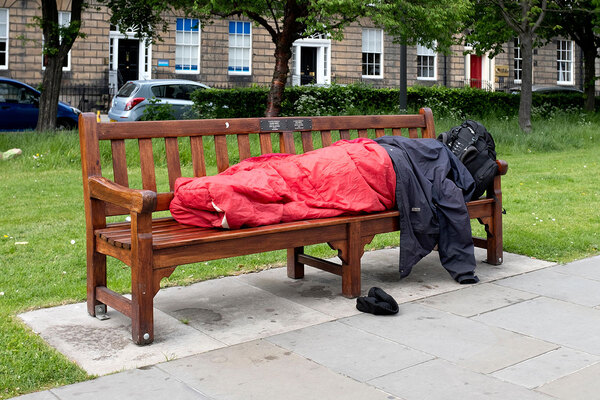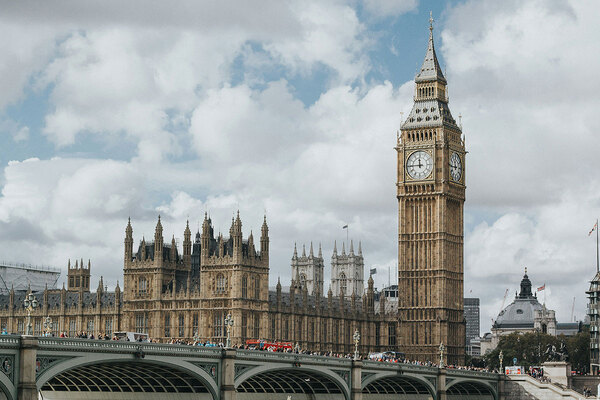You are viewing 1 of your 1 free articles
Birmingham’s temporary accommodation tower
Birmingham City Council has turned an unloved high-rise block into temporary housing for homeless people. Gavriel Hollander finds out how it works. Photography by Fabio De Paola
Barry Jackson Tower in Aston, Birmingham, which was refurbished to be used as temporary accommodation
At 20 storeys tall, Barry Jackson Tower is clearly visible from Birmingham’s infamous Spaghetti Junction just over a mile away.
One Birmingham City Council employee tells Inside Housing how her colleagues are “proud” when they turn off the M6 to make their way into the city and catch a glimpse of the newly refurbished building in Aston, glistening a pristine white in the morning sunshine. That pride comes from what the council has done here.
An unloved 1960s tower block, incongruously dumped among the low-rise estates of the surrounding area, Barry Jackson Tower was a hive for anti-social behaviour and had been scheduled for demolition.
That changed two years ago, when the council hit on the idea of using some of its obsolete buildings as temporary accommodation to alleviate a growing homelessness crisis. In June this year, the first families began moving into the tower’s 160 ‘units’ (the council prefers that word to ‘flats’ when describing temporary accommodation). Meanwhile, to the south of the city centre in Highgate, others were starting to occupy the 55 units at Magnolia House, a former care home.
Inside Housing is being shown around the recently reopened facility during a sweltering hot lunchtime in July by Sharon Thompson, Birmingham’s cabinet member for homes and neighbourhoods and previously its advisor on homelessness. Having been a homeless teen in the city herself, Ms Thompson has a personal incentive to find solutions to what has become an epidemic.
“I think it’s a statement,” she says as we talk in a communal area on the second floor. “In that it’s driving down the use of bed and breakfast [(B&B) accommodation], then, yeah, it’s a huge statement.”
The use of B&Bs as a short-term salve for homeless families has been on the rise in Birmingham. A year ago, according to council data, there were 700 families staying in B&Bs across the city. Today, partly thanks to the opening of Barry Jackson Tower and Magnolia House, that number is below 400.
Ms Thompson says that reducing the reliance on B&Bs is a big motivational factor, not just because it is more expensive for the council to pay for rooms in them than in their own managed accommodation, but also because of the effects it has on people trying to find a permanent home.
“A big thing was when people said they couldn’t bring food in [to B&Bs],” she elaborates. “These things make a huge difference to people.”
“What we don’t want is a cycle of repeat homelessness”
Andy Perry, senior service manager, Birmingham City Council
In contrast, there is a shared kitchen – as well as a shared bathroom – for every two units in Barry Jackson Tower, and an individual fridge for each family. “This shows them that, as a council, we value you as individuals and we will support you in the meantime to get you into permanent accommodation,” adds Ms Thompson.
But the use of B&Bs is just one symptom of a crisis that has engulfed all of the UK’s major cities
this decade, with Birmingham no exception. Street homelessness in the city increased by 53% in the past year and by 588% since 2012.
The last official count in 2018 revealed that 91 people were sleeping rough; in the previous year the count was 57. Meanwhile, the council is handling 600 homelessness applications each month. With 12,900 households already on the housing waiting list and 2,900 in temporary accommodation of one sort or another, it is easy to understand the scale of the challenge.
The repurposing of the two buildings is part of a preventative strategy that launched in 2017, in response to the passing of the government’s Homelessness Reduction Act,
legislation that places the onus on councils to prevent homelessness, rather than take action only once someone becomes homeless.
While Ms Thompson says that Birmingham’s “biggest focus has been getting families out of bed and breakfast”, the strategy – which she herself drew up during her stint as the council’s homelessness advisor – goes further than that.”
“The Homelessness Reduction Act meant we had to change our systems anyway, so we looked at the whole thing together,” Ms Thompson continues. “Barry Jackson and Magnolia are just two of the things that came out of it.”
Inside one of the 160 units at Barry Jackson Tower
She says that the strategy was aimed at “looking at it [homelessness] in a whole system way”, adding that it is being treated as a “city-wide approach, not a council-only approach”.
In practical terms, this approach resulted in the formation of the Birmingham Homelessness Partnership Board, comprising individuals from 30 organisations including charities, private landlords and public sector bodies. The board reviews the council’s progress against the aims of the its homelessness prevention strategy on an annual basis.
The strategy itself has five strands: universal prevention, targeted prevention, crisis prevention and relief, homeless recovery, and sustainable housing. And it appears to be bearing fruit: of the 300 homelessness cases each month that the council identifies as ‘preventable’, 44% are in secure, permanent accommodation six months later.
Ms Thompson explains how the conversion of Barry Jackson Tower and Magnolia House “sits in between” the crisis management and prevention parts of the strategy. That is because besides providing the physical space for families, the two buildings also provide what she calls “wrap-around services” to try and prevent repeat homelessness and put families staying there on the path to getting a home of their own.
“What we don’t want is a cycle of repeat homelessness,” confirms Andy Perry, senior service manager in the council’s temporary accommodation team, which is responsible for the two buildings as well as the four other facilities across the city. “We want people to move on to permanent accommodation.”
There are around 25 council staff working in Barry Jackson Tower, and another nine in Magnolia House, although the level of staffing is constantly assessed. Many of these are in place to provide the kind of services Ms Thompson is talking about. There is, for example, a full-time finance officer on site to help households that might be struggling to get on to Birmingham’s housing register because they are in debt.
“In that it’s driving down the use of B&Bs, it’s a huge statement”
Sharon Thompson, cabinet member for homes and neighbourhoods, Birmingham City Council
Mr Perry says that the officer’s appointments diary is full every week. “There’s a financial angle to lots of people who end up in these circumstances,” he explains.
Haja Obayd and her six children are among the families for whom money was a cause of their homelessness. They were renting privately until they started falling behind on their rent payments and were evicted.
Zartaisha Rashid and her three-year-old son Hussain Ali have been living in a unit at Magnolia House since June
“We were living in hotels and Travelodges for a couple of months,” her 18-year-old daughter Hana Abdul Moore tells Inside Housing. “It’s better here. In the hotels, we didn’t have kitchens and we had to eat out all the time. It’s more like home here.”
Part of that feeling comes from the staff and services that are on offer. Many of the reception and security staff speak Arabic, which Ms Abdul Moore says helps her mother, who sometimes struggles with her English, to feel more at ease. Meanwhile, they are being helped in their application for a permanent home.
In Magnolia House, Zartaisha Rashid has been living in a ground-floor room with a bunk bed alongside her three-year-old son, Hussain Ali, since June. They have been homeless since they obtained a visa 18 months ago.
Ms Rashid tells Inside Housing that she preferred the privacy of her previous temporary accommodation, which she shared with just two other women, but she acknowledges the importance of the additional services she can now access.
“Everyone is friendly and the staff are really nice,” she says. “If you need any help, they are here for you. We are homeless and whatever the council can do, they are doing it for us.”
Financial difficulty has been identified as one of the leading causes of homelessness in Birmingham, but the council’s strategy is also specifically targeting another: domestic violence.
Women’s Aid, a charity that works with domestic violence victims, is one of the 30 organisations with a place on the Homelessness Partnership Board. In March, as part of the over-arching homelessness strategy, the council helped establish a domestic abuse hub, where victims at risk of homelessness can access advice and support.
“We have a system that looks at their needs and their risks [so] we can get the wrap-around support in place,” explains Maureen Connolly, chief executive at Birmingham and Solihull Women’s Aid. She says the work with the partnership board has helped start “conversations about new ways of doing things”.
Sharon Thompson, cabinet member for homes and neighbourhoods at Birmingham City Council
Women’s Aid has a worker in Barry Jackson Tower but Ms Connolly would, on balance, rather victims stay in their own home instead of moving to temporary accommodation whenever possible. “By the time they get here, they are down the road of living with it for a long time,” she elaborates.
It is an illustration of how many intersectional challenges a city like Birmingham has when it comes to homelessness – and how far it still has to go. Nevertheless, the refurbishment of buildings on such a large scale is a clear sign of intent.
The cost of renovating Barry Jackson Tower was £11m, while Magnolia House came in at around £5m. Mr Perry says that Barry Jackson Tower will be “cost neutral” at a 95% occupancy rate. Since it opened at the start of the summer, it has had a 98% occupancy rate. When Inside Housing visits, only one unit is empty, and even that is due to be filled the following day.
There is no time limit for how long people can stay in either of the buildings, with the only restriction being that single men cannot live in any of the units.
“Some families need a few days; some may need two or three months,” adds Mr Perry. “We don’t set timescales for them. You make the call at the right time.”
Timing is also important when it comes to broadening what is still very much a pilot approach.
“What we wanted to do is to make sure to get things right here before rolling it out,” confirms Mr Perry. “What we don’t want is to think we know best and then mess things up. We want to make sure we make the right impact.”
At a glance: Homelessness Reduction Act 2017
The Homelessness Reduction Act 2017 came into force in England on 3 April 2018.
The key measures:
- An extension of the period ‘threatened with homelessness’ from 28 to 56 days – this means a person is treated as being threatened with homelessness if it is likely they will become homeless within 56 days
- A duty to prevent homelessness for all eligible applicants threatened with homelessness, regardless of priority need
- A duty to relieve homelessness for all eligible homeless applicants, regardless of priority need
- A duty to refer – public services will need to notify a local authority if they come into contact with someone they think may be homeless or at risk of becoming homeless
- A duty for councils to provide advisory services on homelessness, preventing homelessness and people’s rights free of charge
- A duty to access all applicants' cases and agree a personalised plan

















